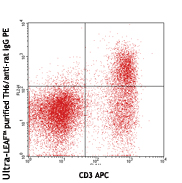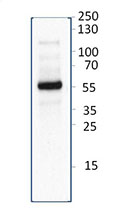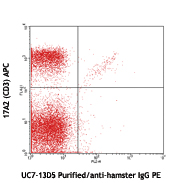- Clone
- 9B1 (See other available formats)
- Regulatory Status
- RUO
- Other Names
- GPR 9-6, CDw199, Chemokine Receptor 9
- Isotype
- Rat IgG2a, κ
- Ave. Rating
- Submit a Review
- Product Citations
- publications

-

C57BL/6 thymocytes stained with Ultra-LEAF™ Purified 9B1, followed by anti-rat IgG FITC
| Cat # | Size | Price | Quantity Check Availability | Save | ||
|---|---|---|---|---|---|---|
| 129711 | 100 µg | $270 | ||||
| 129712 | 1 mg | $743 | ||||
CCR9 is a member of the G protein coupled receptor family and is involved in T cell development in the thymus and in gut-associated immune response. Mouse CCR9 is highly expressed on different stages of thymocytes and upregulated on CD4+CD8+ cells. It is expressed to a much lower level on spleen and lymph node cells. Expression of CCR9 on γ/δ T cells in the intraepithelial and small intestine has been reported. The interaction of CCR9 with its ligand CCL25 (TECK, thymus-expressed chemokine) may direct the trafficking of developing T cells in the thymus and generation of gut-specific immunological memory.
Product DetailsProduct Details
- Verified Reactivity
- Mouse
- Antibody Type
- Monoclonal
- Host Species
- Rat
- Formulation
- 0.2 µm filtered in phosphate-buffered solution, pH 7.2, containing no preservative.
- Endotoxin Level
- Less than 0.01 EU/µg of the protein (< 0.001 ng/µg of the protein) as determined by the LAL test.
- Preparation
- The Ultra-LEAF™ (Low Endotoxin, Azide-Free) antibody was purified by affinity chromatography.
- Concentration
- The antibody is bottled at the concentration indicated on the vial, typically between 2 mg/mL and 3 mg/mL. Older lots may have also been bottled at 1 mg/mL. To obtain lot-specific concentration and expiration, please enter the lot number in our Certificate of Analysis online tool.
- Storage & Handling
- The antibody solution should be stored undiluted between 2°C and 8°C. This Ultra-LEAF™ solution contains no preservative; handle under aseptic conditions.
- Application
-
FC - Quality tested
FA - Reported in the literature, not verified in house - Recommended Usage
-
Each lot of this antibody is quality control tested by immunofluorescent staining with flow cytometric analysis. For flow cytometric staining, the suggested use of this reagent is ≤ 1.0 µg per million cells in 100 µL volume. It is recommended that the reagent be titrated for optimal performance for each application.
- RRID
-
AB_2832467 (BioLegend Cat. No. 129711)
AB_2832467 (BioLegend Cat. No. 129712)
Antigen Details
- Structure
- A membrane of G-protein coupled receptors and contains seven transmembrain domains. Mouse CCR9 has above 80% amino acid sequence homology with human counterpart.
- Distribution
-
CD4+CD8+ thymocytes, γ/δ T cells
- Interaction
- CCL25
- Ligand/Receptor
- CCL25
- Cell Type
- T cells
- Biology Area
- Immunology
- Molecular Family
- CD Molecules, Cytokine/Chemokine Receptors, GPCR
- Antigen References
-
1. Zaballos A, et al. 1999. J. Immunol. 162:5671
2. Wurbel MA, et al. 2007. J. Immunol. 178:7598
3. Wurbel MA, et al. 2006. Eur. J. Immunol. 36:73 - Gene ID
- 12769 View all products for this Gene ID
- UniProt
- View information about CD199 on UniProt.org
Related FAQs
- Does staining at room temperature or even at 37°C help for checking chemokine receptors expression?
-
Due to continuous recycling of many chemokine receptors, it may be worthwhile to consider staining at room temperature or at 37°C if the staining at lower temperature (which can potentially reduce receptor turnover) is not optimal.
- Do you guarantee that your antibodies are totally pathogen free?
-
BioLegend does not test for pathogens in-house aside from the GoInVivo™ product line. However, upon request, this can be tested on a custom basis with an outside, independent laboratory.
- Does BioLegend test each Ultra-LEAF™ antibody by functional assay?
-
No, BioLegend does not test Ultra-LEAF™ antibodies by functional assays unless otherwise indicated. Due to the possible complexities and variations of uses of biofunctional antibodies in different assays and because of the large product portfolio, BioLegend does not currently perform functional assays as a routine QC for the antibodies. However, we do provide references in which the antibodies were used for functional assays and we do perform QC to verify the specificity and quality of the antibody based on our strict specification criteria.
- Does BioLegend test each Ultra-LEAF™ antibody for potential pathogens?
-
No, BioLegend does not test for pathogens in-house unless otherwise indicated. However, we can recommend an outside vendor to perform this testing as needed.
- Have you tested this Ultra-LEAF™ antibody for in vivo or in vitro applications?
-
We don't test our antibodies for in vivo or in vitro applications unless otherwise indicated. Depending on the product, the TDS may describe literature supporting usage of a particular product for bioassay. It may be best to further consult the literature to find clone specific information.
Other Formats
View All CD199 Reagents Request Custom Conjugation| Description | Clone | Applications |
|---|---|---|
| FITC anti-mouse CD199 (CCR9) | 9B1 | FC |
| PE anti-mouse CD199 (CCR9) | 9B1 | FC |
| Alexa Fluor® 647 anti-mouse CD199 (CCR9) | 9B1 | FC |
| Ultra-LEAF™ Purified anti-mouse CD199 (CCR9) | 9B1 | FC,FA |
Customers Also Purchased
Compare Data Across All Formats
This data display is provided for general comparisons between formats.
Your actual data may vary due to variations in samples, target cells, instruments and their settings, staining conditions, and other factors.
If you need assistance with selecting the best format contact our expert technical support team.
-
FITC anti-mouse CD199 (CCR9)

C57BL/6 thymocytes stained with 9B1 FITC -
PE anti-mouse CD199 (CCR9)

C57BL/6 thymocytes stained with 9B1 PE -
Alexa Fluor® 647 anti-mouse CD199 (CCR9)

C57BL/6 thymocytes stained with 9B1 Alexa Fluor® 647 -
Ultra-LEAF™ Purified anti-mouse CD199 (CCR9)

C57BL/6 thymocytes stained with Ultra-LEAF™ Purified 9B1, fo...

 Login/Register
Login/Register 













Follow Us